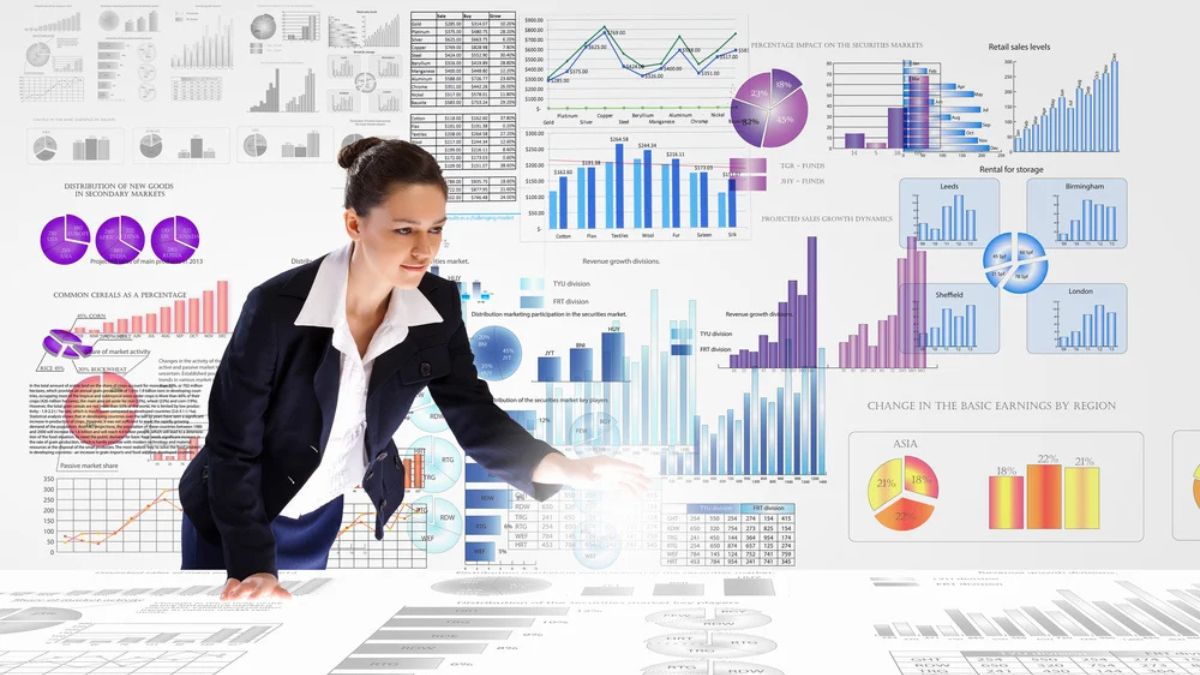BUSINESS
The Impact of Artificial Intelligence on Business and Everyday Life

Artificial intelligence (AI) is no longer just a futuristic concept confined to sci-fi movies—it’s here, transforming industries and reshaping the way we live and work. From improving business processes to enhancing convenience, AI stands at the forefront of innovation and change.
This blog dives deep into the current and future impact of AI across various aspects of life and business. You’ll learn about its practical applications, how it’s shaping industries, and what challenges and opportunities lie ahead.
If you’ve been wondering how AI could influence your personal or professional world, this is the guide for you.
What Is Artificial Intelligence?
Before exploring its impact, let’s take a moment to define artificial intelligence. AI refers to machines and systems designed to simulate human intelligence. This encompasses everything from recognizing patterns and making decisions to learning and adapting based on new information.
AI can be divided into three categories:
- Narrow AI – Specialized systems that focus on specific tasks, such as facial recognition or spam email filtering.
- General AI – Hypothetical systems capable of performing any intellectual task a human can.
- Superintelligent AI – Advanced AI that surpasses human intelligence, still a concept under research.
The AI used today falls under the narrow AI category, finding practical applications in everything from chatbots to medical diagnosis.
AI in Business
Revolutionizing Customer Service
AI has revolutionized the way businesses interact with their customers. Chatbots and virtual assistants, powered by Natural Language Processing (NLP), handle routine customer queries, provide instant responses, and improve user experience.
Example: Many retail companies use AI-powered chatbots (like those from Zendesk and Intercom) to offer 24/7 customer assistance, reducing wait times and improving satisfaction.
Optimizing Supply Chains
AI is also transforming logistics and supply chain management. Predictive analytics and machine learning models forecast demand fluctuations, enabling companies to manage inventory more efficiently.
Example: Amazon leverages AI to optimize its fulfillment centers and predict customer purchase patterns, reducing delivery times and waste.
Enhancing Decision-Making
AI-powered tools like dashboards and analytics platforms transform raw data into actionable insights. These capabilities enable leaders to make informed decisions faster and with greater confidence.
Example: Platforms like Tableau and Alteryx use AI to turn large, complex data sets into visualizations that simplify decision-making.
Automating Repetitive Tasks
AI has reduced the need for human intervention in repetitive administrative tasks. Robotic Process Automation (RPA) systems automate workflows like invoice processing or compliance checks, freeing employees to focus on strategic initiatives.
Example: UiPath is a popular RPA tool that automates repetitive processes, saving both time and resources for enterprises.
AI in Everyday Life
Digital Assistants
From setting alarms to answering complex questions, AI-powered digital assistants—like Siri, Alexa, and Google Assistant—have become an integral part of our daily routines. Their ability to adapt and personalize responses continues to evolve, simplifying everyday tasks.
Personalized Recommendations
When you scroll through Netflix or receive shopping suggestions on Amazon, you’re directly engaging with AI. Recommendation engines analyze your preferences and behaviors to deliver tailored suggestions, greatly improving user satisfaction.
Healthcare Advancements
AI has found a prominent place in healthcare, assisting with everything from early diagnosis to treatment personalization. Tools like virtual health assistants, imaging diagnostics, and predictive analytics have revolutionized patient care.
Example: IBM Watson leverages AI to help medical professionals analyze data and develop treatment plans based on evidence.
Smart Home Devices
AI-powered devices, such as smart thermostats (Nest) and security cameras (Ring), enhance convenience, security, and energy efficiency in homes. They’re designed to learn your habits, making your home more intuitive and responsive to your needs.
Benefits of Artificial Intelligence
1. Increased Efficiency
AI automates time-consuming tasks, allowing employees to focus on higher-value work and organizations to achieve more with fewer resources.
2. Improved Accuracy
With fewer chances of human error, AI systems analyze data and perform tasks with consistent accuracy, from detecting fraudulent transactions to precise medical diagnoses.
3. Personalization
AI can adapt to user preferences, creating more personalized experiences in everything from online shopping to education platforms.
4. Scalability
Businesses can scale operations more effectively with AI, whether it’s managing growing customer bases or processing larger data sets.
Challenges of Artificial Intelligence
Addressing Bias in AI
AI systems learn from data, and if this data contains biases, the AI can perpetuate or even exacerbate them. This poses significant challenges, particularly in areas like hiring or lending decisions.
Privacy Concerns
The widespread use of AI often involves large-scale data collection. Protecting user privacy and ensuring ethical data usage remain ongoing challenges for organizations employing AI.
Ethical Considerations
From questions about job displacement to the potential misuse of AI in surveillance or warfare, implementing AI responsibly is a pressing concern.
The Need for Skill Development
AI’s growing influence means job roles are changing rapidly. Workers will need to upskill and adapt to collaborate effectively with AI systems.
The Future of AI
The future of AI holds impressive possibilities. Advancements like General AI or quantum-enabled AI will likely unlock capabilities we can’t fully imagine yet. Industries such as healthcare, education, and climate science stand to benefit immensely, solving problems at an unprecedented scale.
However, the key will be to implement AI thoughtfully and ethically—ensuring this groundbreaking technology enhances well-being and benefits all.
How Can You Harness AI?
If you’re inspired to integrate AI into your business or personal projects, you’re not alone. Platforms like Jasper provide accessible solutions for automating workflows, enhancing writing, and improving productivity. Get started with free trials and explore how AI can make a meaningful difference in your work and life
BUSINESS
15 Small Business Ideas to Start in 2024

Starting your own small business can be one of the most rewarding experiences of your life. It’s an opportunity to turn passion into profit, be your boss, and pave the way toward financial freedom. But with so many options out there, determining the best small business idea can feel overwhelming.
This blog will explore 15 profitable, low-investment small business ideas perfect for 2024. Whether you’re looking to work from home, explore e-commerce, or offer a unique service, you’ll find plenty of inspiration for your entrepreneurial journey.
Why Start a Small Business in 2024?
The modern business landscape provides more opportunities than ever before. With access to digital tools, global markets, and niche industries, starting a small business has never been more achievable. Plus, consumer trends are favoring small, personalized, and sustainable businesses, giving smaller players a real chance to shine.
With that in mind, let’s explore some exciting and profitable small business ideas for this year and beyond.
Small Business Ideas to Inspire You
1. Social Media Management Services
Every brand, small or large, needs a social media presence—but not everyone knows how to maintain it. If you’re familiar with platforms like Instagram, LinkedIn, and TikTok, you can help businesses grow their audiences, increase engagement, and craft digital strategies.
Start-up investment is minimal; all you need is your knowledge, a computer, and internet access. Consider offering packages for scheduling content, writing captions, or consulting on social trends.
2. E-commerce Store for a Niche Product
Niche products continue to dominate e-commerce because they cater to specific audience needs. Maybe it’s eco-friendly kitchenware, handmade jewelry, or specialized pet accessories. Platforms like Etsy, Amazon, and Shopify make it easier than ever to set up an online store.
Identify a unique product or unmet demand in the market, then create a dedicated store that focuses exclusively on that niche.
3. Freelance Writing and Copywriting
With content continuing to reign supreme for businesses, writers are in high demand. If you have a knack for crafting compelling copy or telling stories, freelancing as a writer could be a lucrative and flexible option.
From blog writing to email marketing, there’s no shortage of clients looking for talented writers. Start by offering your services on platforms like Fiverr or Upwork or reaching out to local businesses.
4. Subscription Box Services
Subscription box services have exploded in popularity for everything from snack kits to beauty products. The idea is simple—curate a box of themed products for a specific niche and deliver it to your subscribers every month.
For instance, you could create a subscription service for gourmet chocolates, outdoor gear, or self-care essentials. This “surprise and delight” model keeps customers coming back month after month.
5. Personalized Fitness Coaching
With the wellness industry booming, there’s a demand for personal trainers and fitness coaches who can deliver tailored fitness solutions. Offering online coaching or a hybrid digital/in-person model means you can reach clients from across the globe.
Think beyond physical fitness. Specialize in areas like pre-natal fitness, weightlifting, or even mindfulness coaching to stand out.
6. Home Cleaning and Organization Services
Professional cleaning and organization services are in high demand as people look to outsource their household responsibilities. Whether helping busy parents declutter the pantry or providing deep-cleaning solutions, this low-investment business offers opportunities for recurring income.
Start small by offering services to friends or neighbors, then grow through referrals and reviews.
7. Digital Marketing Consultant
Businesses of all sizes are looking for ways to stand out in the digital landscape. If you have expertise in SEO, PPC advertising, or content marketing, you can offer consulting services to help businesses create winning strategies.
Having tangible results to showcase in your portfolio is key. If you’re just getting started, consider offering free or discounted work for a couple of clients to build credibility.
8. Pet Services
Are you an animal lover? From pet grooming and sitting to dog walking services, the pet care industry is booming. Busy pet owners are always on the lookout for reliable caretakers for their furry friends.
You can scale this business by adding pet training or even opening a boutique for pet accessories.
9. Custom T-shirt Printing Business
Custom apparel is always in demand, whether it’s for businesses, events, or personal gifts. You can use platforms like Printful or Teespring to start a print-on-demand T-shirt business without needing to manage inventory.
Focus on unique designs or niche categories, such as inspirational quotes or fandom-based merchandise, to carve out a loyal audience.
10. Virtual Assistant Services
Remote work has grown tremendously, and with it, so needs virtual assistants. Entrepreneurs and busy professionals are often willing to hire VAs to manage their schedules, emails, or administrative tasks.
This low-cost business idea allows you to work from anywhere while helping clients tackle their workloads efficiently.
11. Mobile Car Wash or Detailing Services
A dependable, eco-friendly car detailing service can attract customers who value convenience and quality. With the right tools and a mobile setup, you can offer premium services directly in the customers’ driveways.
Offering subscription options for recurring car care could also turn one-time clients into loyal customers.
12. Meal Prep Services
Many people want to eat healthily but don’t have time to prepare meals themselves. A meal prep business that provides freshly cooked meals catering to specific dietary needs (e.g., keto, vegetarian, gluten-free) can be hugely successful.
Work locally at first, delivering meals to your community. Expand by forming partnerships with gyms, grocery stores, or corporate offices.
13. Educational Tutoring or Coaching
Whether it’s academic tutoring for schoolchildren or life coaching for adults, personalized education services are highly sought after. With online platforms like Zoom, you can now reach a wider audience without geographic limitations.
Specializing in a niche subject or skill—such as SAT prep or resume writing—can bolster your standing in the industry.
14. Photography Services
Photography continues to be a lucrative opportunity for business-minded creatives. From weddings and family portraits to professional headshots or brand photography, there are countless ways to specialize in this field.
A strong portfolio and a good social media presence can help you attract clients. Upgrade your gear over time to cater to higher-paying gigs.
15. Sustainable Product Business
The demand for eco-friendly and sustainable products is skyrocketing. Whether you specialize in reusable household goods, biodegradable packaging, or upcycled furniture, there’s a good chance your business aligns with consumer values.
Take the time to research suppliers and materials that adhere to your sustainability mission. Building transparency into your brand’s story will resonate well with eco-conscious customers.
How to Choose the Right Small Business Idea
Still unsure which one suits you best? Here are a few tips to narrow it down.
- Follow Your Passion: Choose something that genuinely excites and motivates you.
- Research Your Market: Understand the demand and competition in your chosen niche.
- Start Small: You don’t need to go all-in overnight—test your idea and grow it over time.
- Utilize Technology: Take advantage of online tools to streamline operations and reach a broader audience.
Build Your Future, One Small Business at a Time
The great thing about starting a small business is that every effort counts. Whether you’re scaling a car detailing company or building a global e-commerce store, the possibilities are endless with determination and the right idea.
Take the first step toward your entrepreneurial dream in 2024 by picking an idea and bringing it to life. Your future self will thank you.
FAQs
Q: How much money do I need to start a small business?
A: The amount needed to start a small business varies widely depending on the type of business. Some ideas, like freelancing or online consulting, require minimal investment, while others, like owning a retail store, may involve a substantial upfront cost. Start small and scale as your business grows.
Q: What is the best small business to start in 2024?
A: The best business aligns with your skills and passions while addressing a market need. Popular trends in 2024 include eco-friendly products, online services, and technology-driven solutions.
Q: Do I need a business plan?
A: Yes, a business plan is essential. It helps you set clear goals, outline strategies, and secure funding if needed. Even a simple plan can provide valuable guidance as you grow your business.
Q: Should I incorporate my business?
A: Incorporating can provide personal liability protection and tax benefits, but it may not be necessary for every small business idea. Research different business structures like sole proprietorships, LLCs, and corporations to determine what’s best for you.
Q: How can I attract my first customers?
A: Start by leveraging your network and social media. Offer promotions, reach out to local communities, or collaborate with other small businesses to gain visibility and trust.
BUSINESS
How to Improve Profitability Without Increasing Prices

Profitability is the lifeblood of a successful business. However, boosting profit margins doesn’t always have to mean pushing up prices and risking customer loyalty. Whether you run a small enterprise or manage a larger organization, there are alternative strategies you can implement to improve your bottom line while keeping your offerings affordable and competitive.
This blog will guide you through actionable steps to increase profitability by optimizing operations, leveraging technology, and streamlining processes. By the end, you’ll have a solid understanding of the strategies applicable to businesses across industries.
What is Profitability, and Why Does It Matter?
Profitability is the ability of a business to generate more revenue than its expenses. It’s not just about making money; it’s about ensuring the long-term sustainability of your organization. A profitable business can reinvest in growth, attract investors, and weather economic storms with greater resilience.
The profitability equation boils down to two factors:
- Increasing Revenue – finding ways to generate more income without alienating customers.
- Lowering Costs – cutting down on expenses without sacrificing the quality of your product or service.
The key to sustainable profitability is identifying areas for improvement within these two factors while aligning them with the customer experience.
Strategies to Improve Profitability Without Raising Prices
1. Streamline Your Operations
Efficiency is the bedrock of profitability. By identifying bottlenecks in operational processes, you can minimize time and resource waste.
- Audit Your Workflow: Document all processes and look for redundancies or inefficiencies. Use tools like value stream mapping to visualize and improve workflows.
- Invest in Automation: Automation tools, such as invoicing software or customer service chatbots, can significantly reduce labor costs without compromising service quality.
- Track Metrics: Use key performance indicators (KPIs) to measure productivity and identify areas requiring adjustments.
2. Reduce Operational Costs
Cutting expenses doesn’t mean sacrificing quality. Small reductions across multiple areas can add up.
- Negotiate with Suppliers: If you’ve been working with suppliers for a while, it’s worth asking for discounts or better payment terms.
- Switch to Efficient Energy Sources: Switching to energy-efficient equipment or utilities not only reduces costs but also aligns your business with sustainability practices.
- Outsource Non-Core Activities: Outsourcing tasks like bookkeeping, IT support, or digital marketing can reduce payroll costs without sacrificing expertise.
3. Focus on Customer Retention
It costs far less to retain a current customer than to acquire a new one. Building long-term relationships with customers ensures consistent revenue.
- Offer a Loyalty Program: Implement a rewards program to encourage repeat purchases.
- Personalize Customer Experience: Use data to tailor recommendations and promotions, making customers feel valued.
- Solve Complaints Swiftly: Address negative feedback effectively to maintain customer trust and loyalty.
4. Upsell and Cross-Sell
Instead of increasing the cost of existing products, look for ways to enhance the value of each transaction.
- Upsell Premium Options: Train your team to suggest premium upgrades to products or services.
- Recommend Complementary Products: For example, if you sell tech gadgets, suggest protective cases or warranties.
5. Leverage Technology
Digital tools and platforms can help you optimize every aspect of your business.
- Use Accounting Software: Tools like QuickBooks or Xero help track expenses, identify patterns, and ensure your financial health is on track.
- Optimize Inventory Management: Implement inventory management systems to avoid overstocking or understocking, which can tie up unnecessary capital.
- Adopt CRM Systems: A customer relationship management platform, such as Salesforce, can streamline communication, track leads effectively, and boost sales.
6. Diversify Your Revenue Streams
Adding complementary revenue streams is another way to boost profitability without touching your prices.
- Launch Digital Products: If applicable, consider selling eBooks, online courses, or other digital content based on your expertise.
- License Intellectual Property: If your business developed proprietary tools, software, or processes, consider licensing them to other companies.
- Collaborate on Partnerships: Explore strategic partnerships that enable cross-promotions or shared product offerings.
7. Invest in Your Team
Engaged and skilled employees contribute directly to productivity and profitability.
- Offer Training Programs: Equip your team with the skills to work smarter, not just harder.
- Align Incentives with Goals: Set up bonus structures tied to the company’s profitability targets.
- Foster a Positive Work Culture: Happy employees tend to deliver better customer experiences.
8. Optimize Pricing Sensibly
Though this article avoids advocating for price hikes, smart pricing strategies can make the most of existing prices.
- Implement Tiered Pricing: Offer basic, standard, and premium options to cater to different customers’ needs.
- Introduce Bundles: Package complementary products or services together at a perceived discount.
- Conduct Regular Reviews: Regularly assess current pricing structures to ensure alignment with market trends and costs.
9. Maximize Marketing ROI
Many businesses use marketing without understanding which strategies are most effective. Trim excess spending by focusing only on high-return channels.
- Use Data-Driven Marketing: Platforms like Google Analytics help identify which tactics bring the most conversions, so you can allocate your budget efficiently.
- Harness Content Marketing: Creating valuable blogs, tutorials, and case studies can organically drive traffic and build trust.
- Engage in Social Media: Social platforms are cost-effective for outreach if targeted well.
Real-Life Success Stories of Improved Profitability
- Starbucks: The coffee giant optimized profitability by streamlining operating efficiency and implementing small menu changes that reduced waste, like introducing reusable mugs and eliminating unnecessary ingredients.
- Netflix: By leveraging customer data, Netflix developed personalized content recommendations, leading to higher subscription retention rates.
- Small Retailer: A local boutique achieved a 20% profit increase by introducing loyalty programs and using predictive analytics to manage inventory better.
Small Changes, Big Impact
Improving profitability doesn’t need to be daunting or require dramatic changes. Often, the combination of several small, strategic adjustments can significantly impact your bottom line. Start by identifying areas where you can reduce waste, streamline processes, or improve efficiency. From there, continually fine-tune your strategies using feedback and performance data.
A profitable business is not only more sustainable but also better equipped to grow and thrive in a competitive market. Remember, long-term profitability is a continuous process, not a one-time goal. Take action today to build a brighter, stronger future for your company.
FAQs
1. How can I identify areas for improvement in my business?
Start by analyzing your financial statements and performance metrics. Look for inefficiencies, high costs, or declining revenue trends. Conducting customer surveys and gathering employee feedback can also provide valuable insights into problem areas and opportunities for growth.
2. What is the best way to reduce waste in operations?
Reducing waste can involve optimizing inventory management, minimizing unnecessary expenses, and streamlining workflow processes. Tools like Lean principles or workflow automation can help identify and eliminate operational inefficiencies.
3. How do I know which small changes will have the biggest impact?
Focus on areas that align with your business goals. Use performance data to prioritize changes that have a measurable impact on revenue, cost savings, or customer satisfaction. Implement changes gradually and assess their effectiveness before scaling further.
4. Should I invest in technology to improve profitability?
Investing in technology, such as customer relationship management (CRM) tools, inventory management software, or data analytics platforms, can be highly beneficial if aligned with your strategic goals. Assess the expected return on investment (ROI) before making a decision.
5. How often should I review my profitability strategies?
Regular reviews are essential. Consider scheduling quarterly or biannual assessments to ensure your strategies are effective and adapt to any changes in the market, customer preferences, or operational needs. This ongoing evaluation keeps your business resilient and competitive.
BUSINESS
Overview of Comerica: Personal & Business Banking, Wealth Management

Comerica has established itself as a key player in the banking industry, offering a range of services tailored to meet diverse needs. Whether you’re an individual seeking personal banking solutions or a business looking for robust financial support, Comerica provides reliable options that stand out. With their innovative tools and dedicated customer service, navigating your financial journey becomes easier. Let’s explore what Comerica has to offer across personal banking, small business services, commercial offerings, and wealth management solutions.
Personal Banking
Comerica’s personal banking services are designed to make everyday financial management simple and efficient. From checking and savings accounts to credit cards, they provide options that cater to various preferences and lifestyles.
Customers can benefit from online banking features, which allow easy access to account information anytime, anywhere. With competitive rates and Personalization support, Comerica ensures that your banking experience is both seamless and rewarding. Whether you’re saving for a goal or managing daily expenses, their offerings stand out in the market.
Small Business Banking
Comerica offers tailored banking solutions for small businesses, ensuring their unique needs are met. From checking accounts to credit lines, the services aim to simplify financial management and boost growth.
With competitive rates and personalized support, Comerica empowers entrepreneurs to focus on what they do best. Whether it’s managing cash flow or seeking funding options, small business owners can rely on expert guidance every step of the way.
Commercial Banking
Comerica’s commercial banking services cater to businesses of all sizes. They offer tailored solutions that address the unique financial needs of each client, ensuring efficient operations and growth potential.
From traditional lending options to innovative cash management tools, Comerica supports companies with expert guidance. Their team is dedicated to helping organizations navigate complex markets while maximizing their resources for sustainable success. Whether you’re expanding or maintaining stability, Comerica’s comprehensive offerings play a vital role in your business journey.
Wealth Management
Wealth management at Comerica focuses on personalized strategies to help clients grow and protect their assets. Their team of experienced advisors works closely with individuals and families, tailoring services to meet unique financial goals.
From investment management to estate planning, Comerica offers a comprehensive suite of solutions. Clients benefit from ongoing support, ensuring that their wealth is managed effectively through changing market conditions and life events. With a commitment to empowering financial success, they are dedicated to fostering long-term relationships built on trust.
Comerica Business Connect
Comerica Business Connect is a powerful tool designed to streamline banking for small and medium-sized businesses. It offers an intuitive online platform that makes managing finances easier than ever.
With features like real-time account access, transaction monitoring, and customizable alerts, business owners can stay on top of their financial health. The integration with other Comerica services ensures that your banking experience is seamless and efficient, allowing you to focus more on growing your business rather than navigating complex processes.
Comerica Treasury Mobile® App
The Comerica Treasury Mobile® App offers a convenient way for businesses to manage their finances on the go. Users can easily access account information, approve transactions, and monitor cash flow with just a few taps.
Designed with security in mind, the app allows you to perform banking tasks confidently. Additionally, real-time alerts help keep you informed of any updates or changes to your accounts. This mobile solution empowers business owners to stay connected and make informed decisions anywhere, anytime.
Customer Support
Comerica offers robust customer support designed to meet various needs. Clients can access dedicated assistance for personal and business banking inquiries, ensuring prompt resolutions.
For added convenience, the bank features an Interactive Voice Response (IVR) system available 24/7. This allows customers to manage their accounts anytime without waiting on hold. Whether it’s loan assistance or simple account questions, Comerica’s commitment to service shines through in every interaction.
Loan Assistance
Comerica offers tailored loan assistance to help clients navigate their financial needs. Whether you’re looking for a personal or business loan, knowledgeable representatives are ready to guide you through the options available.
With various lending solutions, Comerica ensures that you can find the right fit for your situation. From application support to managing repayments, they prioritize customer satisfaction and accessibility throughout the borrowing process. Get in touch with a representative today to explore how Comerica can assist with your loan requirements.
Interactive Voice Response (IVR) System 24/7
Comerica’s Interactive Voice Response (IVR) system is designed for your convenience. Available 24/7, this service allows you to access account information and perform banking transactions anytime, anywhere.
You can quickly check balances, transfer funds, or make payments without waiting on hold. The user-friendly prompts guide you through the process smoothly. Whether it’s day or night, the IVR system ensures that help is just a phone call away when you need it most.
Consumer Loans
Comerica offers a variety of consumer loans to meet your needs. Whether you’re looking for a personal loan, auto financing, or home equity lines of credit, they have options designed to make borrowing straightforward.
Their competitive rates and flexible terms help you choose the right solution. The application process is user-friendly, allowing you to manage your finances with ease. With Comerica’s support, achieving your financial goals becomes more attainable than ever before.
Business Loans
Comerica offers a variety of business loans designed to meet diverse needs. Whether you’re looking to expand your operations, purchase equipment, or manage cash flow, their loan options can help you achieve your goals.
With competitive rates and flexible terms, Comerica makes it easy for small businesses to access funding. Their experienced team works closely with you to tailor solutions that fit your specific situation and financial objectives. Let them support your growth journey with the right financing.
Self-Service Phone Banking
With Comerica’s Self-Service Phone Banking, you can manage your accounts anytime. This feature allows you to check balances, transfer funds, and review transactions without needing to visit a branch or log into an app.
The convenience of 24/7 accessibility means you can handle banking tasks on the go. Whether you’re at home or traveling, this service simplifies your financial management. Just dial in and access essential features with ease. It’s designed for those who value efficiency in their banking experience.
Contact Information
When it comes to banking needs, knowing how to reach out for assistance is crucial. Comerica offers various channels for customer support. You can visit their website for online resources or call their dedicated service lines directly.
Their representatives are available to help with inquiries ranging from account management to loan services. Whether you’re looking into personal banking options or business solutions, getting in touch is simple and straightforward.
For those who prefer self-service methods, the Comerica Treasury Mobile® App provides a user-friendly interface that allows you to handle many banking tasks on your own. Just choose the method that best fits your needs and get started today!
-

 TECH9 months ago
TECH9 months agoExploring Precision Technologies International: The Future of Advanced Engineering
-

 TECH9 months ago
TECH9 months agoStevens Institute of Technology: Pioneering Innovation and Excellence in Education
-

 NEWS9 months ago
NEWS9 months agoThe NYT’s Take on British Affairs: A Comprehensive Review
-

 FINANCE8 months ago
FINANCE8 months agoInvestiit.com Tips: Maximizing Your Investment Success
-

 HEALTH9 months ago
HEALTH9 months agoThe Ultimate Guide to Physical Therapy Web Design That Converts
-

 NEWS3 months ago
NEWS3 months agoTop 5 Reasons to Follow UKOBIW.com for Your Daily News Fix
-

 CROSSWORD & PUZZLES6 months ago
CROSSWORD & PUZZLES6 months agoVault Opener NYT Crossword: An Informative Guide
-

 HEALTH9 months ago
HEALTH9 months agoThe Allure of Candy Red: A Bold Hue That Never Goes Out of Style
